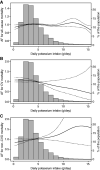Dietary Potassium Intake and All-Cause Mortality in Adults Treated with Hemodialysis
- PMID: 34853064
- PMCID: PMC8729497
- DOI: 10.2215/CJN.08360621
Dietary Potassium Intake and All-Cause Mortality in Adults Treated with Hemodialysis
Abstract
Background and objectives: Dietary potassium restriction in people receiving maintenance hemodialysis is standard practice and is recommended in guidelines, despite a lack of evidence. We aimed to assess the association between dietary potassium intake and mortality and whether hyperkalemia mediates this association.
Design, setting, participants, & measurements: A total of 8043 adults undergoing maintenance hemodialysis in Europe and South America were included in the DIETary intake, death and hospitalization in adults with end-stage kidney disease treated with HemoDialysis (DIET-HD) study. We measured baseline potassium intake from the Global Allergy and Asthma European Network food frequency questionnaire and performed time-to-event and mediation analyses.
Results: The median potassium intake at baseline was 3.5 (interquartile range, 2.5-5.0) g/d. During a median follow-up of 4.0 years (25,890 person-years), we observed 2921 (36%) deaths. After adjusting for baseline characteristics, including cardiac disease and food groups, dietary potassium intake was not associated with all-cause mortality (per 1 g/d higher dietary potassium intake: hazard ratio, 1.00; 95% confidence interval [95% CI], 0.95 to 1.05). A mediation analysis showed no association of potassium intake with mortality, either through or independent of serum potassium (hazard ratio, 1.00; 95% CI, 1.00 to 1.00 and hazard ratio, 1.01; 95% CI, 0.96 to 1.06, respectively). Potassium intake was not significantly associated with serum levels (0.03; 95% CI, -0.01 to 0.07 mEq/L per 1 g/d higher dietary potassium intake) or the prevalence of hyperkalemia (≥6.0 mEq/L) at baseline (odds ratio, 1.11; 95% CI, 0.89 to 1.37 per 1 g/d higher dietary potassium intake). Hyperkalemia was associated with cardiovascular death (hazard ratio, 1.23; 95% CI, 1.03 to 1.48).
Conclusions: Higher dietary intake of potassium is not associated with hyperkalemia or death in patients treated with hemodialysis.
Keywords: cohort studies; diet; dietary; hemodialysis; mortality; nutrition; potassium.
Copyright © 2021 by the American Society of Nephrology.
Figures




Comment in
-
Should We Let Dialysis Patients Eat Their Fruits and Veggies?Clin J Am Soc Nephrol. 2021 Dec;16(12):1781-1783. doi: 10.2215/CJN.13521021. Epub 2021 Dec 1. Clin J Am Soc Nephrol. 2021. PMID: 34853059 Free PMC article. No abstract available.
References
-
- World Health Organization : Diet, Nutrition, and the Prevention of Chronic Diseases: Report of a Joint WHO/FAO Expert Consultation. Geneva, Switzerland, World Health Organization, 2003
-
- National Kidney Foundation : Dietary guidelines for adults starting on hemodialysis, 2019.. Available at: https://www.kidney.org/atoz/content/dietary_hemodialysis. Accessed April 2, 2020
-
- Picard K, Griffiths M, Mager DR, Richard C: Handouts for low-potassium diets disproportionately restrict fruits and vegetables. J Ren Nutr 31: 210–214, 2021 - PubMed
-
- James G, Jackson H: European guidelines for the nutritional care of adult renal patients. EDTNA ERCA J 29: 23–43, 2003
-
- Daugirdas JT, Blake PG, Ing TS: Handbook of Dialysis, Philadelphia, Lippincott Williams & Wilkins, 2001
Publication types
MeSH terms
Substances
LinkOut - more resources
Full Text Sources
Medical

